By Karen Glenn BPTMN, Posted by Patricia Crain Class of 2018
Article V of the Rewilding Series
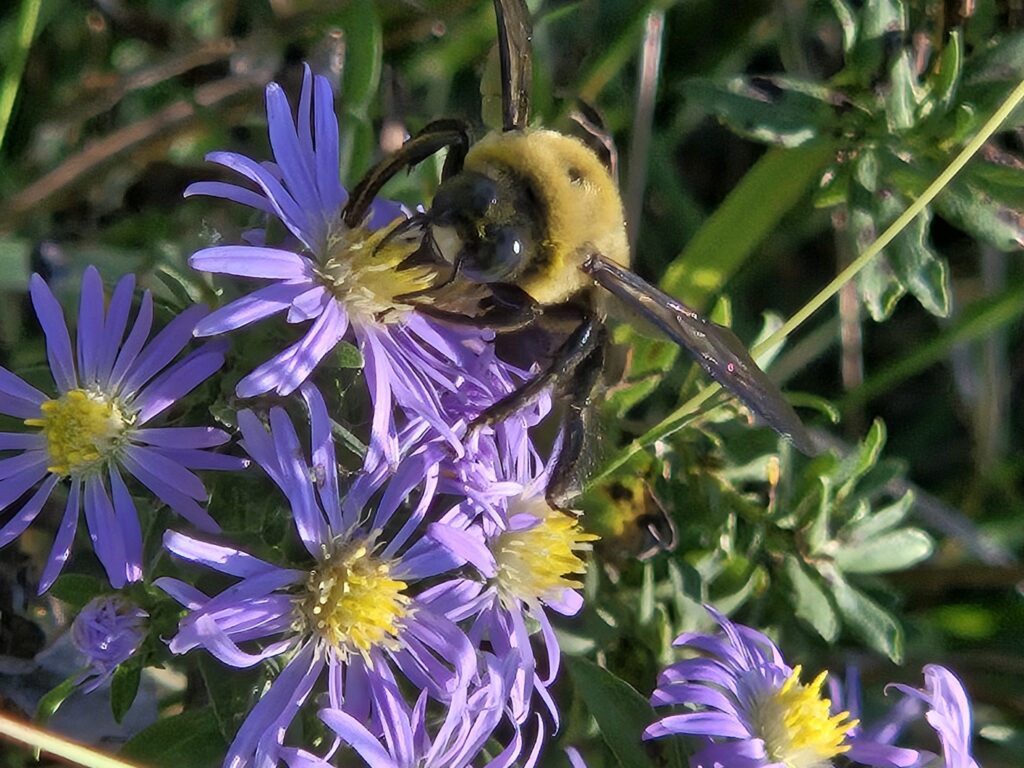
Leaves are beginning to drop from trees and shrubs, summer plants are drying out and turning dormant, and the fall bloomers are beginning to slow down a bit as the occasional cooler weather prepares us for the winter ahead. We are currently experiencing another false fall. There may be more summer-like days, but soon cool days will be here. That means it is almost chore time. Purple asters and goldenrod are the dominant plants still actively producing forage for the pollinators on Sticker Hill. The tall gaura is done, for the most part, so the tall stalks are bare giving the impression of a sheer curtain in the areas it gathered. The late boneset and marsh fleabane are taking a break. They will bloom again soon, but for now the goldenrod and asters are doing a good job providing resources for the local bees and butterflies. I visited Hagerman NWR a couple of weeks ago, and the Butterfly Garden was still full of late summer and fall bloomers. One of the most popular plants the day I visited was the Blue Mistflower, Conoclinium coelestinum, which I hope to add to this property soon. It was filled with butterflies, bees, and other pollinators.

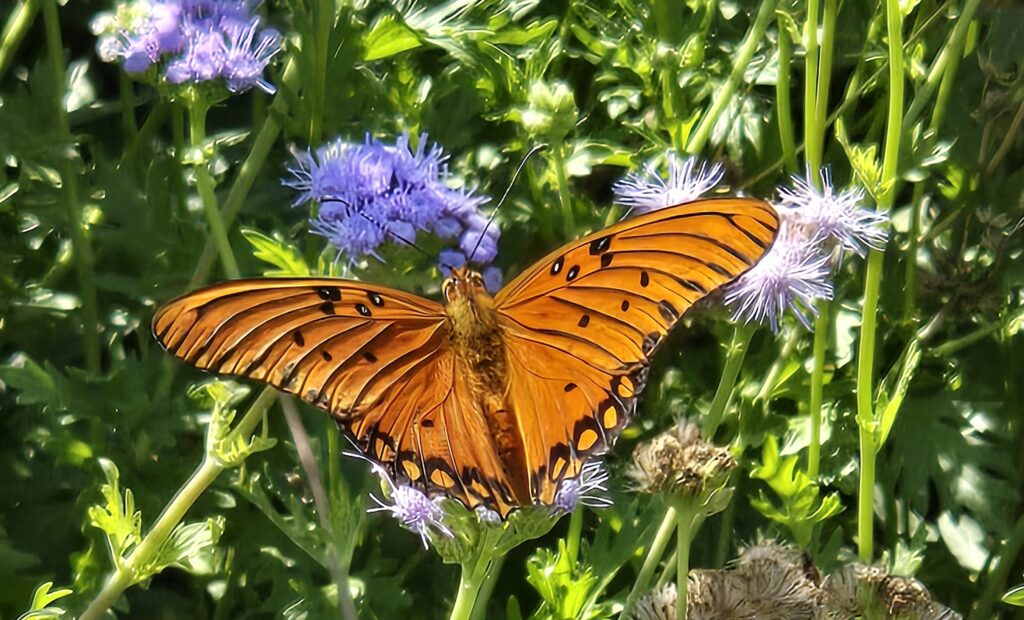
A Gulf Fritillary, Dione vanilla, and a Common Buckeye, Junonia coenia, on a Blue Mistflower, Conoclinium coelestinum, at the Hagerman NWR Butterfly Garden.The garden is still full of local pollinators and gorgeous blooms.
Fall is a great time to look over the past growing season to see what worked, what didn’t, and make plans for next year. It is also a great time to seed grass for next season. I have been spreading native grass seeds all month. We seeded the pasture with big bluestem (Andropogon gerardii). Indiangrass (Sorghastrum nutans), and little bluestem (Schizachyrium scoparium). We also added blue grama (Bouteloua gracilis) and sideoats grama (Bouteloua curtipendula) in areas where shorter grasses were needed. There will be no raking of leaves on Sticker Hill but there will be some minor clearing of small trees and shrubs that have popped up over the past few years. I usually wait 2-3 years before deciding whether to take small trees down, but there have been so many volunteer redbud, persimmon, and catalpa trees popping up that many will be removed as seedlings. There is currently too much shade at the front of the property, so this winter we will be removing quite a bit of woody growth. The trees will be used to build a couple of new wood piles, which will provide shelter this winter for the smaller critters on the property.
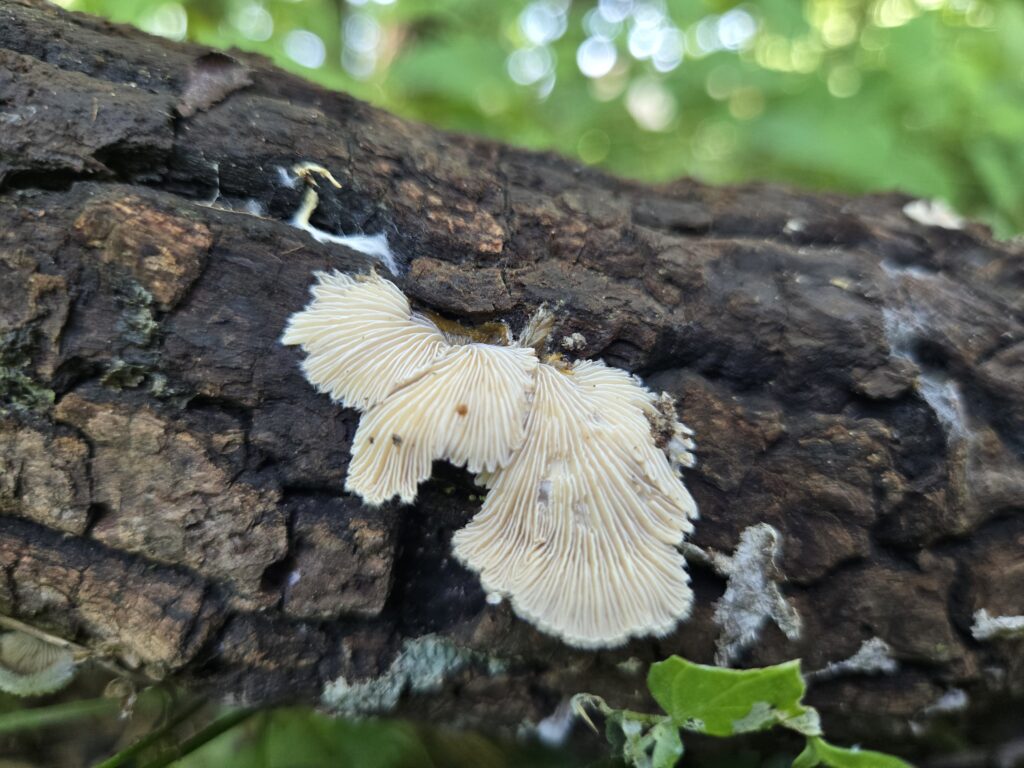
A splitgill mushroom, Schizophyllum commune, colony on an old persimmon branch. This common fungi will rapidly break down smaller trees and branches.
| When small diameter trees are used, wood piles quickly return to the soil as stored carbon. I will probably burn a small amount when the burn ban is lifted for Grayson County, but not much since burning releases the carbon back into the air as carbon dioxide. Allowing fungi to return the trees to the soil adds organic matter rich in carbon and other nutrients. This builds healthy soil and gives soil organisms an abundant energy source. One of my goals is to capture as much carbon as possible with plantings, then return the plant material back to the soil using natural processes. This helps to build and sustain a healthier ecosystem.This is also the time of year when the local peppervine needs a bit of thinning and clearing. Peppervine, Nekemias arborea, is a native vine in the Grape Family (Vitaceae) with beautiful foliage and colorful berries. Often mistaken for poison ivy, it is an attractive, fast-growing plant, but it may be a poor choice for smaller spaces. Peppervine will take over quickly, if you let it, but it isn’t too difficult to control with a little maintenance. |
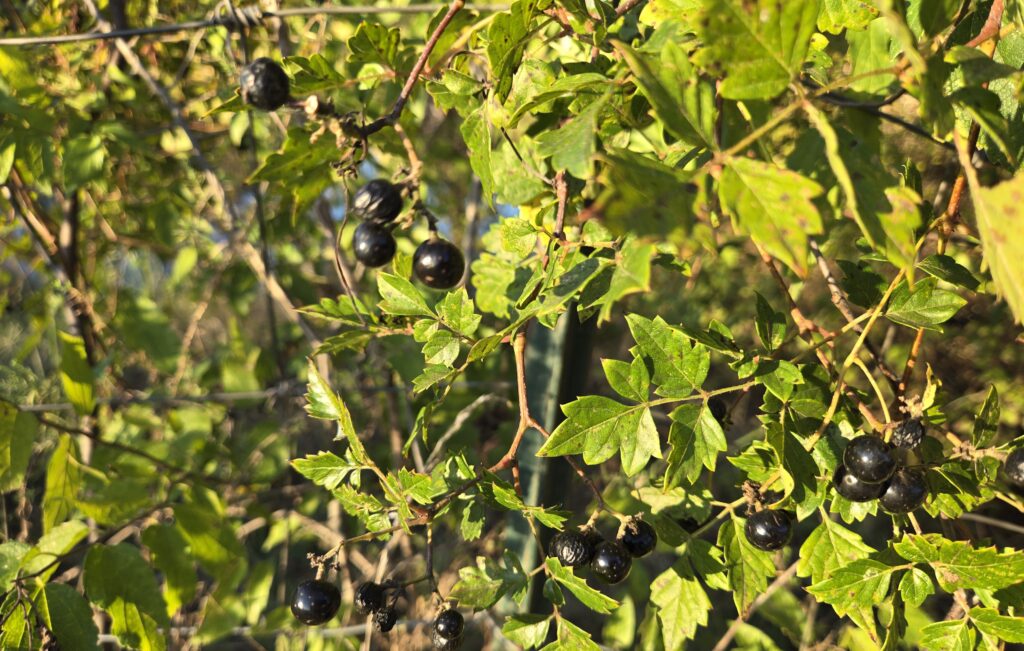
Peppervine, Nekemias arborea, produces berries which start out white, then alternate with bright blues, reds, and purples until they reach a deep, glossy black color when ripe. The berries are not considered edible by humans and cause throat irritation, but this native vine is favored by many pollinators and songbirds.
Once the berries are eaten by wildlife, the vines are cut at the ground, dried out, and added to a woodpile. Dried peppervine also makes a great fire starter for campfires, and it is recommended to avoid planting near homes and other buildings because of its flammable nature. Some gardeners have referred to this plant as the “plant from hell” but it is native to Texas, so I am trying to learn how to manage it and figure out what companion plants can compete with it to help hold it in check. Many plants have bad reputations mainly because they can outcompete the non-native plants we try to keep in our spaces. I try to evaluate the native plants that appear on Sticker Hill as unbiased as possible. The native Peppervine has not caused a problem yet, but it has an invasive cousin, Amur Peppervine (Amelopsis glandulose) that appeared at the same time. Another name for the invasive species is porcelain berry, and it was sold as an ornamental, due to its colorful berries. It has large heart-shaped and three-lobed leaves, so the two vines are easy to tell apart, even without fruits present. Since it is invasive, it must go!
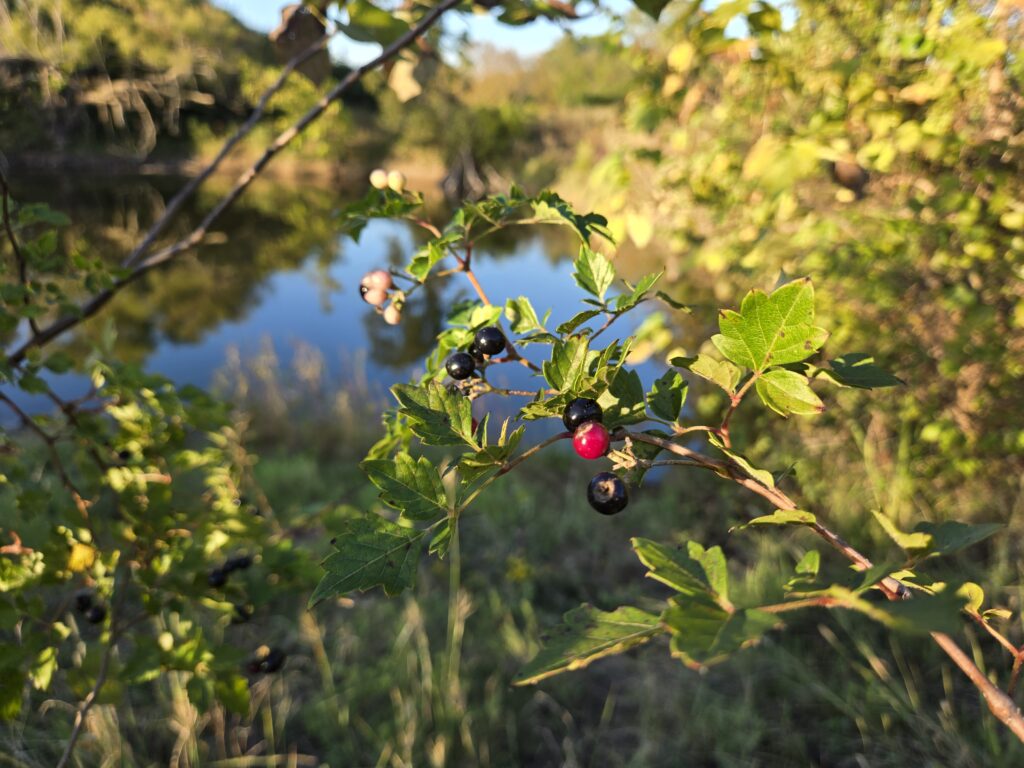
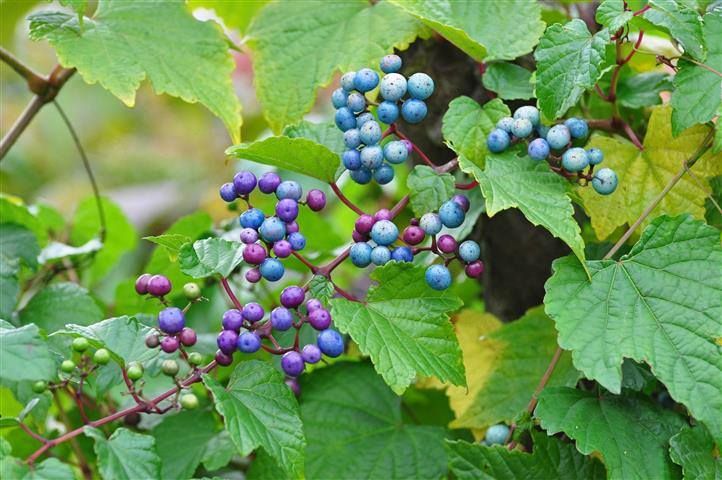
Left: The fruit of peppervine (Nekemias arborea) is a little under a half-inch across and quite popular with songbirds and small mammals. The berries are stripped off the vines rapidly as they ripen. Right: Invasive Amur Peppervine (Amelopsis glandulose), a cousin of native Peppervine. It is beautiful, but it does not belong in the native landscape. Notice the difference in the leaves from the native peppervine.
If you have room for a roaming ground cover or a quick growing semi-evergreen screen, native peppervine might be a good choice. It happily covers the fence along the driveway. With proper support it can grow 30 feet or more in a season, although my vines rarely get over 7-8 feet on the fencing. Peppervine prefers to live on the edges of woods and along fence rows. This plant also has a reputation for taking down smaller trees (which could be beneficial, if trying to weaken or remove woody thickets, especially before a burn). Wildlife of all kinds use this plant from the leaves and flowers to the shiny black berries, although it is not considered edible by humans. The ripe berries have calcium oxalate crystals, which are harmful, if swallowed. If small children are in the vicinity, that may be something to keep in mind. Songbirds and small mammals have no trouble eating the sweet berries, though. If it becomes problematic and must be removed, most of the resources suggest cutting it at ground level and applying a broad leaf herbicide directly to the open cut. Young plants are easily pulled up, roots and all.
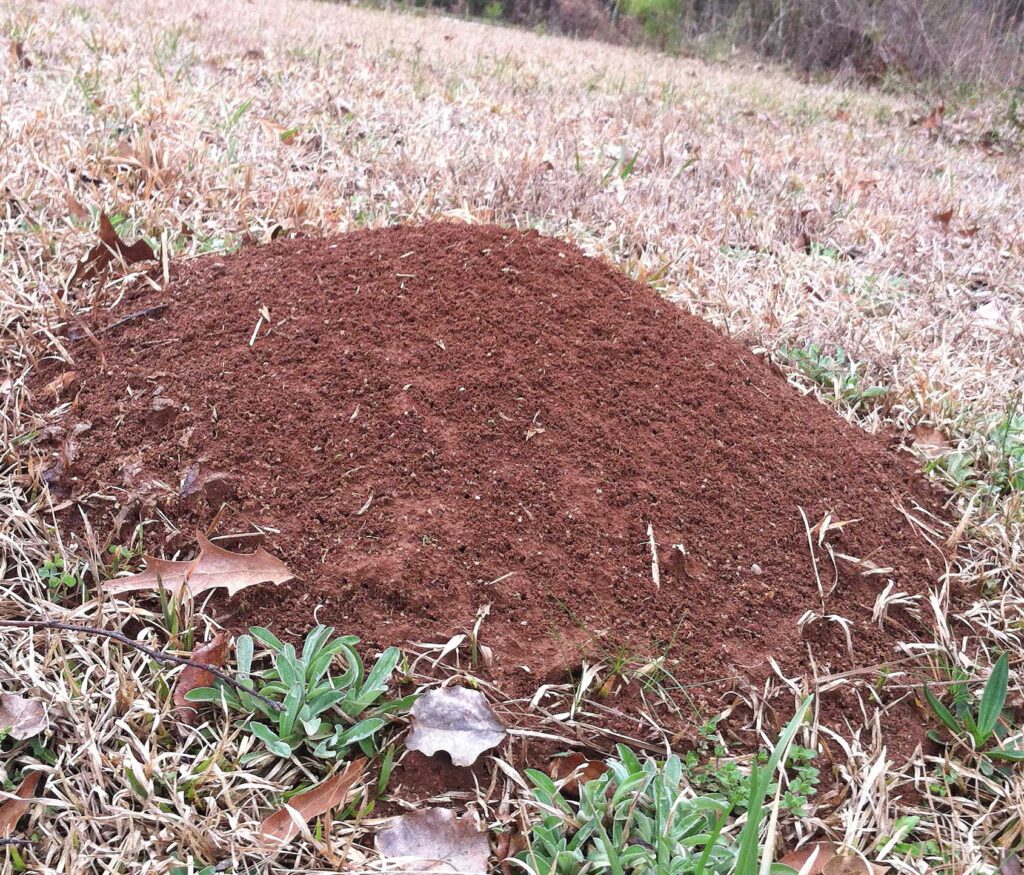
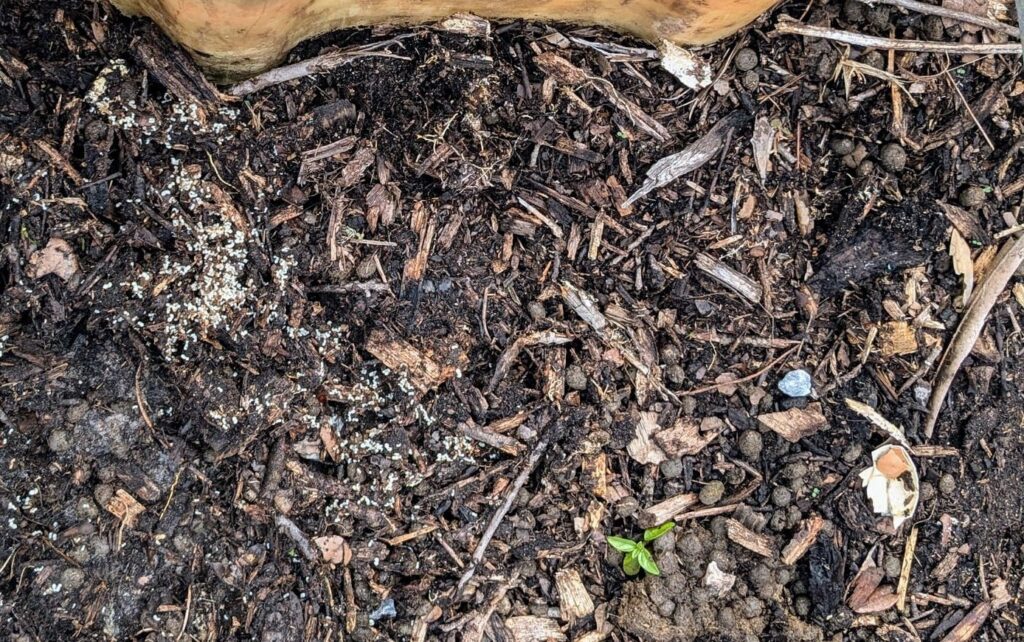
Fire ant mounds are easier to see in the winter months. A disturbed mound shows eggs the worker ants will bring to the surface after the first treatment. It is important to treat the mound with a second drench of boiling water to eliminate any survivors. The process may be repeated as often as necessary for large colonies.
Another chore for this time of year is fire ant control. It is never ending, but this is the time that the spring and summer ground covers dry up, so hidden mounds become visible. I try not to use synthetic baits and poisons on the property and prefer physical methods to remove unwanted invasive species. For fire ants my method of choice is the good old trusty tea kettle! A little gravity and boiling water works wonders to kill the ant colonies, while leaving behind no toxic residue. Plus, it is satisfying hearing the water percolate deeply into the underground passages! The soil provides insulation that holds in heat as it effectively kills the ants. After the first drench, wait about 20-30 minutes, then drench again. Any workers who survived the first round will be moving the eggs and resources up to the soil surface, so a second treatment usually eliminates any survivors that may have been in side passages. If it is an older, deeper mound, more treatments may be needed, but most of the time two tea kettles full of water per mound will suffice. This is the safest and most effective fire ant treatment I have found. It is instantaneous, safe to use around ponds, pets, and livestock, and there are no worries about toxic residues. So, if you see me wandering around out in a pasture with a tea kettle in my hand, I am not out of my mind (although this is debatable), I am stalking fire ants!
Karen Glenn is a member of the Hagerman Committee of the Blackland Prairie Master Naturalists. See more of her articles at FriendsOfHagerman.org/rewilding. For more articles like this one, check out the Friends of Hagerman NWR monthly Featherless Flyer.



[…] Rewilding Sticker Hill: Is it Finally Fall? […]